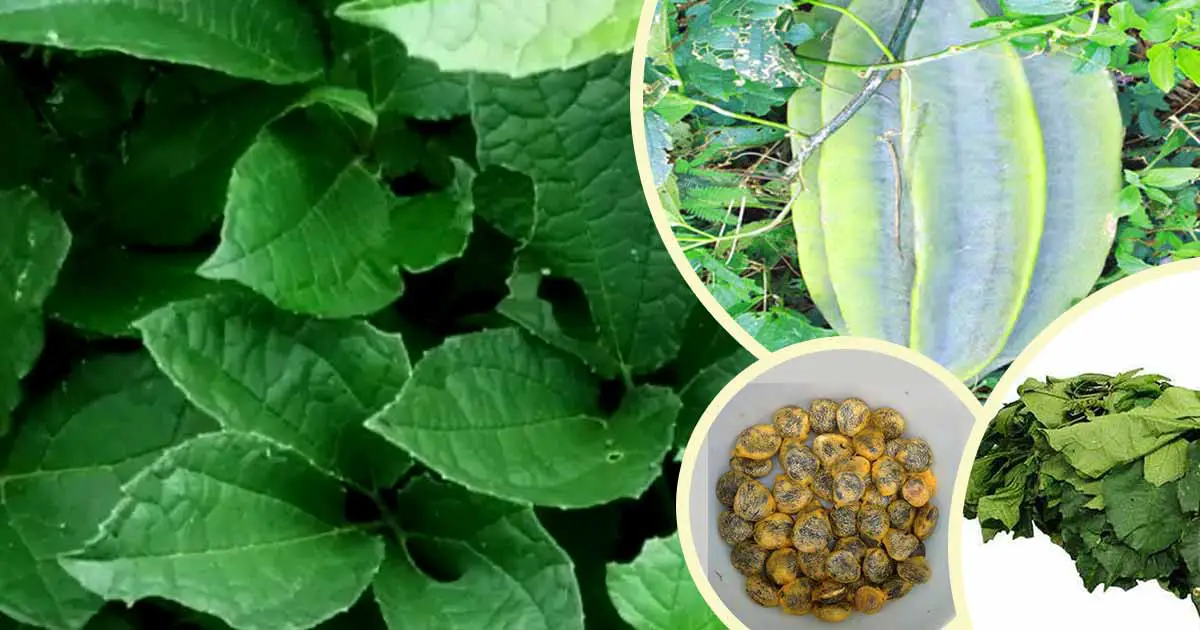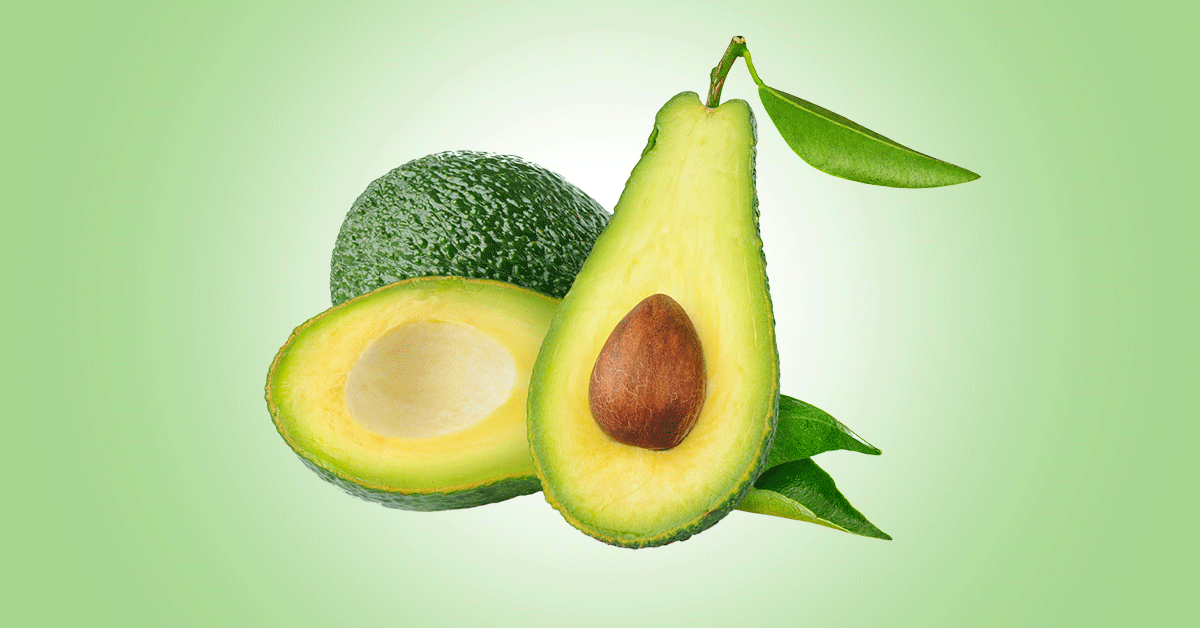Fluted Pumpkin (Telfairia occidentalis) is a plant belonging to the Cucurbitaceous family. The leaves and seed of the vegetable plant are consumed. Cucurbitaceae family contain plants like cucumber, watermelon, squashes like pumpkin. They have also been called gourds and are mainly grown in tropical parts of West and Central Africa and South America. It is abundant in Nigeria, Benin, Uganda, Angola, Sierra Leone, and Cameroon.
The large perennial plant is a climber. The stem has five ridges, with hairs when young. It has branching and long twisting tendrils. Leaves are dark green, with 3-5 foliates. Blades and petioles of the leaves are covered with hairs. The seeds are dark red, non endospermic, and are enclosed in a bright-yellow fibrous endoscarp. This fruit is very large and are marked by 10 obvious longitudinal ridges.
It is called fluted pumpkin or fluted gourd because of the shape of the female flowers that looks like a flute.
Among the Igbos in Nigeria, where it is very popular, fluted pumpkin is called Ugu or Ugwu. It is called Iroko, Eweroko, or Aporoko (Yoruba), Umee (Urhobo), Ubong (Efik) and Umeke in Edo, ekobon (Cameroon), Oroko, pondokoko and Gonugbe (Sierra Leone), Krobonko (Ghana), Costillada (Spanish). Other names of fluted pumpkin include oil nut, fluted gourd and Telfairia nut. It is different from Telfairia pedata, the oysternut, a distinct plant.
In Nigeria, there are two main varieties, ugu-ala, with succulent broad leaves, small black seeds, thick stem, and slow growth, and ugu-elu, with large brown seeds, thin stem, small leaves and faster growth rate. Ugu-ala is of higher demand due to the large succulent leaves.
The tender shoot, the succulent leaves and the immature seeds are nutritious and are used for cooking. They are also used in traditional medicine. The immature seeds can also be boiled and eaten. The dried or fresh seeds are used as a thickener in vegetable soups.
The fruit is a berry called pepo. In preparation of soup with fluted pumpkin leaves, it can also be paired with melon seeds or okra. The young seeds and pulp are also made into marmalade.
Composition of Fluted Pumpkin Leaves
The leaves of fluted pumpkin (100g) contains 86g of water, 2.9g of protein, 1.8g of fat, 7g of carbohydrates, 1.7g of dietary fiber, and 147kj of energy.
The mineral content includes iron, phosphorus, sodium, magnesium, calcium, potassium, copper, zinc, and vitamins like carotene and vitamin A, E, vitamin C, niacin, riboflavin, thiamine, and folic acid.
It is important to cook the leaves to reduce the antinutrients levels. The antinutrient such as oxalates are of higher quantity in the fresh leaves and stems, than older ones.
Composition of the Fluted Pumpkin Seed
Fluted pumpkin seed is nutritious. It can be roasted, or boiled, and eaten. It also serves as a soup thickener. Likewise, it has high quantity of oil (30 -40%) especially unsaturated fatty acids, and so it is a healthy oil which may be used for cooking. It also has adequate crude proteins, carbohydrates, moisture, crude fiber, and ash – Longe et al. (1983).
Calcium, phosphorus, sodium, potassium, and vitamin A, vitamin C, are the minerals and vitamin composition.
Amino acid portion include alanine, arginine, aspartate, cystine, glycine, glutamine, histidine, lysine, methionine, phenylalanine, tryptophan, tyrosine, leucine, serine, threonine, valine, and isoleucine. Glutamic acid content was the highest, followed by aspartic acid, and leucine.
Oleic acid is the highest amount of unsaturated fatty acid; it is about 36 % value of all fatty acids.
The phospholipids include phosphatidyl ethanolamine, phosphatidyl inositol, phosphatidyl choline, phosphatidyl serine, lysophosphatidyl choline, and phosphatidylglycerine. Glycolipids include digalactosyldiglyceride, Steryl glycoside, monogalactosyldiglycerid, and cerebroside.
Neutral lipids include triglycerides, diglycerides, sterylesters, free sterols, and monoglycerides.
Young seeds are preferable as they have less anti-nutrients, and are sweeter.
The Root, Pod and Pulp
The root of fluted pumpkin contains potassium, calcium, magnesium, and sodium. It also contains high quantity of anti-nutrients such as oxalates.
The pod and pulp contains crude protein, crude fiber, moisture, ash, ether extracts and nitrogen-free extracts.
Bioactive Compounds
Phytochemical analysis of fluted pumpkin leaves reveals the presence of bioactive compounds such as alkaloid, saponin, flavonoid, cardiac glycoside, and steroids.
The root also contains tannins, reducing sugars, glycosides, saponins, sterol and triterperoids, while the stem and leaves contain tannins, flavonoids, alkaloids, saponins, steroids, anthraquinones, and reducing sugars.
The leaves contain unsaturated fatty acids such as palmitoleic acid, elaidic acid. Seed contains pentadecanoic acid, hexadecanoic acid, linoleic acid, dodecanoic acid, α-campholene aldehyde, trans-β-ocimene, borneol, α-phellandrene, stigmastan-3-ol, and terpinen-4-ol.
Alkaloids have antimicrobial activity, and also nerve stimulant, muscle relaxant activity. Saponins have anti-inflammatory activity.
Cardiac glucosides have sedative and antispasmodic activities. They could be helpful in circulatory issues, cardiac insufficiency, and coughs.
Flavonoids are significant polyphenols with antioxidants (radical scavenging), anti-inflammatory, anti-allergic, and vasodilator property.
The leaves also contain essential oils while the root contains lactones, sesquiterpenes, and cucubitacine. The root may have rodenticide activity.
Health Benefits of Fluted Pumpkin Leaves and Seeds
Rich in antioxidants: Fluted pumpkin leaves contain natural antioxidants such as tocopherols, ascorbic acid, carotenoids, lycopene, proanthocyanins, and flavonoids.
These compounds prevent free radicals that cause damage to body cells and lead to diseases such as cardiovascular diseases, cancer and neurodegenerative diseases like Parkinson’s disease, and Alzheimer’s disease.
Blood boosting: As a home remedy, fresh ugu leaves are mixed with milk as it believed to increase blood levels. This is because it contains a high level of iron, which may help in the treatment of anemia, especially in children.
Antidiabetic effect: Oxidative stress due to generation of reactive oxygen species and decrease in antioxidants is one of the factors that increase the risks of diseases such as atherosclerosis, and type 2 diabetes.
Extract of fluted pumpkin leaves have been found to prevent diabetes in glucose induced hyperglycemia, and streptozotocin (STZ) induced diabetic mice (Aderibigbe et al. 1999), but did not alter glucose levels in normoglycemic rats.
Antimicrobial activity: Telfairia occidentalis extract is reported inhibiting the growth of Enterobacteriaceae such as Escherichia coli, Pseudomonas aeroginosa, S. faecalis, Proteus sp. and Salmonella typhi. However, it did not inhibit fungi such as Aspergillus favus, Aspergillus fumigatum, Penicillium italium and Geotrichum albidun (Oboh et al., 2006). .
Odoemena and Essien (1995) also reported the antibacterial activity of the root extract against Staphylococcus aureus, Streptococcus pyogenes, Shiegella dysenterae and Kliebsiella pneumoniae.
Antimalarial activity: The extract of fluted pumpkin has antiplasmodial activity. The root extract has blood schizontocidal activity comparable to standard drug, chloroquine (Okokun et al. 2007).
Also, the leaf extract showed antiplasmodial activity both in the 4-day early infection test and established infection, with increase in mean survival time. In vitro studies showed synergistic activity with choloroquine in CQ-tolerant P. berghei isolates.
Hepatoprotective activity: Telfairia occidentalis has antioxidants that protect against free radical damage, and liver damage. Extract of the leaves protect the liver against garlic-induced liver damage (Oboh 2005).
Nwannna and Oboh (2007) also reported that the extract protect the liver against acetaminophen-induced liver damage.
Rich dietary fiber content: Rich dietary fiber content in fluted pumpkin leaves is one of the added health benefits. Dietary fiber are indigestible compounds that help to boost the digestive system, prevent constipation, and reduce the risk of colon cancers, and build up of cholesterol in the arteries.
General well-being: The leaves are a rich source of essential minerals such as potassium, and iron. It has vitamins such as niacin, folic acid, riboflavin, vitamins C, E, and A that helps to maintain normal body function, growth, and development of cells, tissues, and organs.
Anti-inflammatory activity: Fluted Pumpkin leaves contain phytochemicals such as saponin, alkaloids, and flavonoids. These compounds have anti-inflammatory activity and help to stabilize the erythrocyte membrane.
The leaf of T. occidentalis significantly inhibited carrageenan-induced oedema in the sub-planar hind paw of rats. The seed extract showed significant anti-inflammatory activity against egg albumin and xylene-induced oedema.
Effect on male fertility: Telfairia occidentalis improved the seminal fluid, regeneration and increased
spermatogenesis. Leaf extract also increased sperm motility, sperm viability and sperm count in rat.
The seed oil increased testosterone levels, luteinizing hormone, sperm count, sperm motility and weight of the testicle when compared to the alcohol treated rats.
The fertility activity may be due to high carbohydrate, arginine, zinc, vitamin C, and E which are beneficial to male fertility. Also, antioxidants helps to prevent free radical damage and improve fertility.
Anticancer effect: Fluted pumpkin contain compounds such as phenolic compounds, flavonoids, phytosterols, tannins, saponins, chlorophyll, and glycosides. They have antioxidant and anti-inflammatory activities, and may prevent cancers.
Also, the seed extract of T. occidentalis decreased serum prostatic acid phosphatase concentrations, increased testosterone: estradiol ratio. It also decreased the mass and secretory activity of the enlarged prostate. This makes it beneficial in managing benign prostatic hyperplasia in rats.
Treatment of convulsion: In traditional medicine, the young leaves are sliced and mixed with coconut water and salt for the treatment of convulsion.
Toxic effect of Fluted Pumpkin
The aqueous root of Telfairia occidentalis may be harmful to the mucosa lining of the stomach. The root is also reported to be nephrotoxic.
References
- https://www.researchgate.net/publication/325530690_Nutrient_Quality_Studies_of_Fluted_Pumpkin_Telfairia_Occidentalis_Hook_F_Leaves_as_Influence_by_Fertilizer_Microdosing_and_Micro-Dosing_Time
- https://www.researchgate.net/publication/274694148_Some_Medicinal_Values_of_Telfairia_occidentalis_A_Review
- https://www.tjpr.org/vol13_no10/2014_13_10_28.pdf
- https://scialert.net/fulltext/?doi=ajbmb.2011.30.38
- https://tropical.theferns.info/viewtropical.php?id=Telfairia+occidentalis











